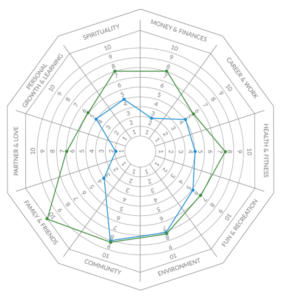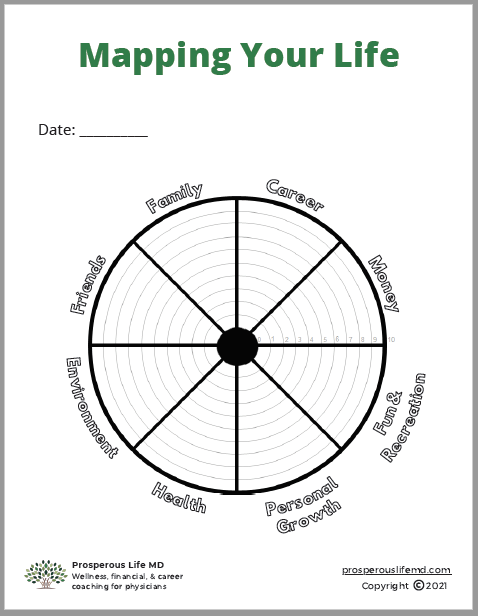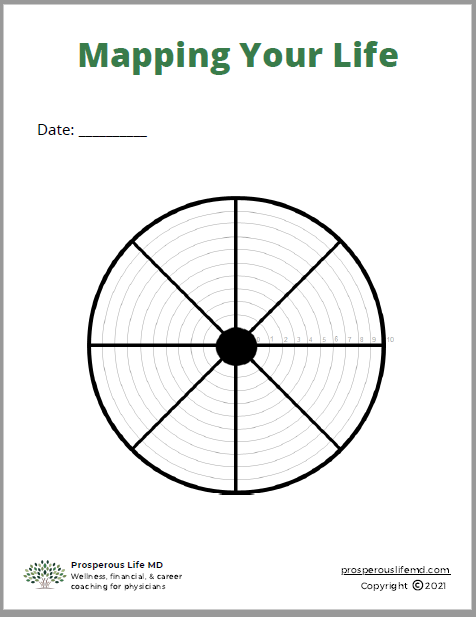Join Stop Charting at Home absolutely free & learn to leave your work at work
Last week I introduced a life coaching tool called the wheel of life and how it could be used to map out the six underlying causes of burnout.
That post had a free downloadable PDF of the wheel of life as it pertained to burnout.
This week’s post pulls back a little to a more general use of the wheel of life—in a form you may have even seen previously.
Within this post is TWO free downloadable PDFs of the wheel of life for your life mapping enjoyment!

The Wheel of Life
As promised, first the two downloadables:
Click here or the image above to download and save this wheel of life with prefilled segments. Then you can print off copies as needed.
Click here or the image above to download and save this wheel of life with blank segments for you to fill out as you please. Then you can print off copies as needed.
The Great Schism
I gave some background last week on the wheel of life to which you can refer and that I won’t rehash here.
However, I did leave out one important facet about them:
You may think that the wheel of life is without controversy, but not even this seemingly innocuous tool can escape debate!
What am I talking about?
Wheels of life come in two main formats: pie and spider web.
I’m pretty staunchly a pie guy myself and that’s what I’ve presented thus far to you. It’s also the format all of my relevant downloadables incorporate.
I like the pie wheels of life not only because they remind me of pie, but also because I find them easier to read and interpret at a glance.
In the interest of being balanced, I will show you what a spider web wheel of life looks like. But consider yourself warned.
Readers may find the following image disturbing. Reader discretion is advised. For mature audiences only.

Oh, the humanity!
If you’re still with me, I’m sorry you cannot unsee that ghastly sight. You should know that that’s one of the best spider web wheels of life I’ve ever seen, so yeah.
In underground wheel of life circles, pie versus web is like Team Jacob vs Edward.
In all seriousness, I find that in the web format it is sometimes hard to distinguish relative values between segments. There is also far more variability in how they can be filled out.
I prefer the simple things…like pie.
The Eight Segments
Last week’s burnout-related wheel of life featured six segments. Most wheels of life I’ve come across feature eight, but it’s not uncommon to see more.
The segments together represent one way of describing your life and vary to some degree, but typically include:
- Work/Career
- Family
- Friends
- Money
- Fun/Recreation
- Health
- Personal Growth
- Environment (this is often substituted for Spirituality)
In contradistinction to my burnout wheel of life, these wheels are designed to have clients rank their level of satisfaction in each area (on a scale from 0-10).
You are free to interpret each segment as you choose. If you don’t like these segments, I’ve included the blank template for you to write-in whatever domains better represent a description of your life!
Which aspects of your life are screaming “pick me?”
Fill Me Out Before You Go-Go
The steps are the same as detailed in last week’s post, but to summarize:
- Fill in the Date
- Grab Your Colors (Ideally, the same number of colors as segments)
- Rate Each Area (Remember: put the first number that comes to your mind, not the number you think it should be)
- Map Out Your Ratings
- Assess & Plan
- Repeat (Pick an interval that serves you, but at least annually).
Pros of Using a Wheel of Life
I think wheels of life are useful. If I didn’t, then I wouldn’t waste your time with them. Here are a few of the specific reasons why I like them.
First, wheels of life give you a big picture view of your life (assuming you pick a variety of domains). The graphical representation means you can quickly grasp the whole situation at hand.
The act of filling one out forces you to pause and reflect on your values and priorities. Taking stock like this is never a bad idea.
Furthermore, they can help you determine if you’re living your values. For example, if you say that family is your number one priority and you score low in this area, then either you’re not living that value and it’s causing duress or it’s not truly a value for you. That on which we focus our time and attention is that which is important to us. If there’s an area in which you’re “deficient,” then you can concentrate your efforts to improve or make changes in this area.
Wheels of life also give you a snapshot of how you’re doing in whatever domains you select. This means you can measure progress (or regression) across time by comparing snapshots.
Finally, and probably most importantly, wheels of life are quick to fill out and easy to do. The most stressful aspect of them is finding the correct color palette to use.
Oh, you don’t have that problem? Only me?
I choose all of them! (Not sure what myth they were busting on this episode of Myth Busters!?)
Cons of Using a Wheel of Life
Wheels of life are not all sunshine and roses.
No, there is no dark, sinister side to them (spider web versions aside).
But they do have their limitations and features of which I’m not a fan.
Namely, wheels of life can be too vague and nebulous for some. Some may find them too simplistic. Like most things, you need the right tool for a specific job.
Furthermore, they assign equal weight (via the 0-10 scale) to each segment, which implies all are equal in importance. Wheels of life are often used to promote such “balance.”
Now I don’t believe in balance. Balance is bullsh*t.
It’s not about balance. It’s all about priorities, and those can vary within a day, day to day, or within larger timeframes.
Your priorities are based on your values. If you valued everything equally and prioritized them as such…you wouldn’t have prioritized anything!
Said differently: assigning equal value to everything negates the point of assigning a hierarchy (i.e., prioritizing).
Hmm…I’m going off on a tangent, maybe I should save this rant for a future post.
Anyway, equal segments on wheels of life may drive over-emphasis on certain domains that are not equally valued.
For example, if a wheel includes “Environment” or “Spirituality,” then that may not resonate with you as something of importance and you rate it lower making it seem like you’re deficient in this area when it’s not an issue for you.
Don’t let a wheel put you in a box.
Harmonize!
If my rant above made you think I’m anti-wheel of life, know that I’m not (unless it’s a creepy spider web one).
Achieving your version of a value-based, prioritized existence is essential to your wellbeing. Call it your harmony.
Harmony here not meaning balance (were you paying any attention above!?), but instead aligning your time with your values such that what you prioritize in life gets your focus and attention.
If you decide that a wheel of life can be a useful tool in your arsenal, then I encourage you to download my templates above or create your own!
Have you filled out a wheel of life? What did you think? You better not say it helped you find balance, so help me—I mean, let me know in the comments below!
If you haven’t subscribed to my email list, then do so below so you don’t miss my new posts or my weekly updates (only for subscribers).
I’d also be most appreciative if you shared this post with anyone whom you think would benefit from the content or message of the blog. They may similarly be most appreciative 


